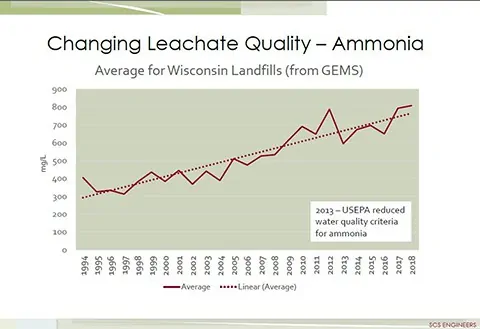

Managing landfill leachate and wastewater treatment are increasingly challenging and costly for landfill owners and operators. In some cases, publicly owned treatment works (POTWs) are required to impose limitations on liquids received at their facilities, resulting in increased charges, or the POTW could refuse to permit or process the leachate wastewater altogether. These developments are due in part to more stringent discharge requirements and the shift to newer disinfection technology that has limited the POTW’s ability to accept higher strength wastewaters. As a result, many facilities and landfill operators are facing higher costs and fewer options for disposal.
Another factor that affects landfills is the fact that the composition of leachate in landfills differs depending on the degree of leachate stabilization and a seasonal increase in quantity as well as on the influence of more frequent and higher intensity storms due to changing climatic conditions.
The single most influential factor on the volume of landfill leachate is precipitation. The most influential factor regarding leachate quality is that leachate typically contains high concentrations of organic compounds, ammonia and other forms of nitrogen, metals, and dissolved solids. Ammonia concentrations in the leachate, from many landfills, are increasing every year as shown in the graph below. Compounding the high strength concentrations of constituents found in landfill leachate are the emerging contaminants of concern including per and poly-fluoroalkyl substances (PFAS) that are now a significant concern with the U.S. EPA and many state environmental agencies.

Top 5 Questions and Answers When Selecting the Right Leachate Treatment Option for Your Landfill
Without considering leachate recirculation and a host of other factors, this blog provides answers to frequently asked questions regarding the analysis of treatment options for landfill leachate.
ONE: What is an example of a typical work scope of a leachate treatment options analysis?
TWO: What information is necessary to begin assessing the on-site treatment options of leachate?
THREE: What constituents should I expect to have analyzed to assess the options for leachate wastewater treatment?
FOUR: What are some of the issues taken into account regarding treating ammonia-N in leachate/wastewater?
FIVE: What are some examples of the options for how to effectively treat ammonia-N in leachate on-site?
We hope you find our SCS Advice from the Field blogs helpful. For more information, we recommend these articles and resources: